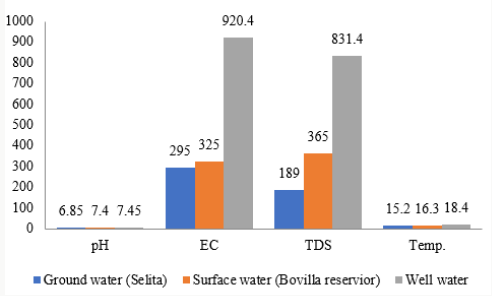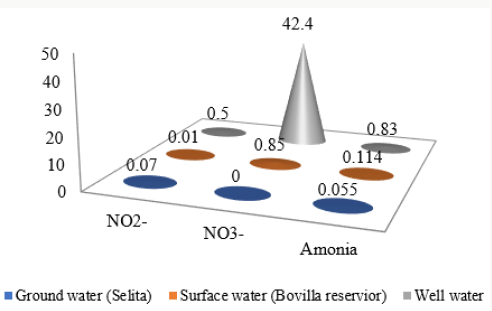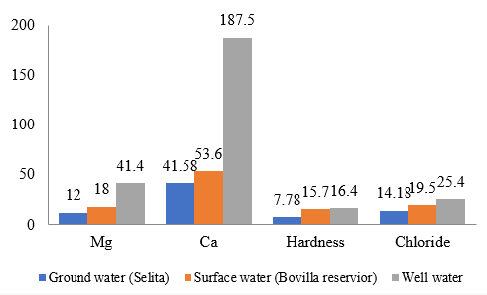
Lupine Publishers Group
Lupine Publishers
Menu
ISSN: 2637-4676
Research Article(ISSN: 2637-4676) 
Assessment of Basic Physical-Chemical Parameters in Drinking Water in Tirana, Albania Volume 5 - Issue 2
Milidin Bakalli1* and Albim Hoxha2
- 1Faculty of Professionals Sciences, Albania
- 2Albim Hoxha, Central Laboratory of Armed Forces, Albania
Received: November 01, 2018; Published: November 09, 2018
Corresponding author: Milidin Bakalli, Faculty of Professionals Sciences, Durres, Albania
DOI: 10.32474/CIACR.2018.05.000210
Abstract
Tirana is one of the major Cities of Albania, which used water from three different types of water resource, groundwater from spring, surface water (Bovilla reservoir) and private well water. Groundwater and surface water managed by Municipality of Tirana and kept under control of Laboratory of Water-Sanitation. Whereas private well water isn’t kept under control by public institution like Laboratory of Water-Sanitation of Tirana or Public Health Institute. Groundwater and surface water are according of network distribution by pipeline. This water used by people as a tap water. According to the Laboratory of Water-Sanitation of Tirana water is suitable for drinking water and fulfills quality of Albanian standard. The present study was designate to examine the physicochemical water quality from ground water, surface water and private well water. Water samples were collected for a period of three months from April to May 2017 and analyzed for water quality parameters by following standard methods. All samples analyzed for pH, Temperature, EC, TDS, Total hardness, Calcium, Magnesium, Chloride, Nitrite, Nitrate, and Ammonia. Data analysis was performed by statistic calculation. By observing the results, it can be concluded that parameters which were taken for tap water quality are below the pollution level. Whereas at the private well water was found some parameters such as nitrate and ammonium are over the permissible values. Other parameter which has high level is hardness and this water classified as “moderate hardness”. In general, water from Selita and Bovilla sources that used in Tirana City is suitable for drinking and uses for some various purpose like domestic, agricultural, industrial etc.
Keywords: Tap Water; Quality; Physicochemical; Tirana; Pollution
Introduction
Water is essential in the process of digestion, circulation, elimination, and the regulation of body temperature. In fact, the activity of every cell in the body takes place in a watery environment. Water is important as a solvent. Many substances dissolve in water amongst which salt, sugar and alcohol [1,2]. In general, the physical characteristics of water are not of direct public health concern, but they do affect the aesthetic quality of the water, which largely determines whether or not people are prepared to drink it. If water is unpalatable or appears to be of poor quality, even though it may be quite safe to drink, the consumer may seek other water sources that may not be as safe. Inorganic chemicals in drinking water usually occur as dissolved salts such as carbonates and chlorides, attached to suspended material such as clay particles, or as complexes with naturally occurring organic compounds. Organic compounds are usually present in drinking water in very low concentrations; they may occur either naturally or as a result of human activities. The byproducts of disinfection are the products of reactions between disinfectants, particularly chlorine, and naturally occurring organic material such as humic and fulvic acids, which result from the decay of vegetable and animal matter. Of these disinfection byproducts, the trihalomethanes (THMs) are produced in the highest concentrations. Most disinfectants used to render drinking water safe from pathogenic microorganisms will produce byproducts in the disinfection process. Most of surface water resources have been polluted by agricultural and industrial activities and sewages, but underground water resources are still known as safe water, because of the natural filtration process in soil texture. High concentration of chemicals in drinking water may cause serious problems for human health [3,4]. For instance, the presence of nitrate can cause methemoglobinemia which is a very dangerous disease especially for risk groups like children under 3 and people with deficiently in HB MET enzyme [5].
The aim of this paper is to assess the quality of drinking water for basic physic-chemical parameters from three sources in Tirana city. Water quality is highly related to general environmental status of any area. However, the quality of water can be change from many different factors. Tirana city has a wide variety of geological conditions, and take water from three sources, (springs) underground water, surface water and private wells. Water from springs and surface source collected into depots and is under the judicature of Water supply and sanitation of Tirana. Wells water doesn’t certify as a drinking water by Public Health Institution yet. Most people used these wells, have not tested the quality of water. Based on some studies the quality of drinking water used in Tirana city in some case doesn’t fulfill the standard, because some parameters are above the permeable limit [6-9].
Materials and Methods
Samples were taken at three sources like spring water (Selita) reservoir (Bovilla) and wells water. The samples from Selita and Bovilla were taken at tap water. For sampling in wells, we chose some wells in villages near the Tirana city. This water used for domestic and sometimes as drinking water. We chose PET container, and all water samples were conservation for chemicals analysis of NO3-, NH4+, [10]. These samples are transported by box refrigerator and analyzed during the same day. The number of analyzed samples was 100. Parameter likes pH, temperature, TDs and Conductivity was measurement during the sampling. Nitrate, nitrite and ammonia are tested UV-Vis spectrophotometers, while rest parameters with classical method. Methods of testing were EN ISO and all the reagents used were AR reagents. For assess the water quality we used the Decision of Council Ministry no 379, date 25.05.2016, Quality of Drinking Water. Samples were analyzed at the Laboratory of Chemicals Analyses at Central Laboratory of Armed Forces in Tirana.
Results
The results of chemical and physical analysis of water quality at Tirana City during 2017 are presented on Table 1, and the average values have been compared with the Decision of Council Ministry no 379, date 25.05.2016, “Quality of Drinking Water”. In Table 1 showed that temperature of water ranged from 8,7 to 19 0C. We know that temperature is an important biological factor in the metabolic activities of the microorganism. The pH of water ranged from 6,1 to 7,9 which express intensity of acid or alkaline solution. The values of EC ranged from 220-947 μScm-1. This parameter in some cases may link to the total dissolve solids and both increase the corrosives feature. TDS ranged from 168-942. The results have also shown that levels of nitrate, nitrite and ammonia ranged respectively from 0 -50,3, 0,006-1,2 and 0,02-1,23 mg/l. The presence of nitrate, nitrite and ammonia in water above the limit shown that water may contaminated by outside factors as agriculture fertilizes, waste or sewage drainage. Other parameters like magnesium, calcium, chloride and total hardness ranged respectively from 6.8-49,3, 36-200, 6-16,4 and 12,5-32,4. Hardness was expressed as German degree. At Figures 1-3 these data were expressed as average value. We noticed for all the parameters values have increased trend from Selita source to Bovilla reservoir and the largest value were at wells water (Table 1).
Based on the average values we can say the water samples from the Selita source fulfill the chemicals parameters for drinking water. Samples from Bovilla reservoir may classify this water as moderate hardness and the value of ammonium was at the limit permissible. The results for wells water were different. Samples from these wells don’t fulfill the parameters for drinking water. Nitrite and ammonium were over the limit of permissible. Based on TDS value these samples categorize a fair. This water may categorize between moderate to hard refer the hardness values.
Conclusion
Based on the data we may display our conclusions about the quality of drinking water used in Tirana city from three sources (underground water, surface water and wells water). The quality of water is linked to the type of sources but in some cases pollution of drinking water from supply is linked to the different factors like interaction of people, amortization of pipeline supply and sewage system. Another factor that affects the quality of water was the heavy rainfall and infiltration of spills which mixed with damaged pipeline. Different situation was for private wells. Samples from wells water had almost high level of ammonia nitrogen. This chemical indicator is linked with the bacteriological indicator. Other parameter which has high level is hardness. Based on the values this water classified as “moderate to hard”.
References
- George I Sackheim, Dennis D Lehman (1977) Chemistry for Health Sciences (4th edn.), Macmillan Publishing Co, pp. 122-138.
- WHO (2004) Guidelines for drinking water quality,Geneva.
- Mastoi GM, Shah SG, Khuhawar MY (2008) Assessment of water quality of Manchar Lake in Sindh (Pakistan). Environmental Monitoring and Assessment 141: 287-296.
- WHO (2003) Guidelines for drinking water quality, W.H. Organization, Editor, Geneva, pp: 81-87.
- Tirado R (2007) Nitrates in drinking water in the Philippines and Thailand. Greenpeace Research Laboratories Technical.
- M Bakalli, M Hysko (2013) Determination of Physicochemical Parameters in Well Water used as Drinking Water in Military Zone. International Journal of Ecosystems and Ecology Sciences 3(1): 49-52.
- M Bakalli, M Hysko, J Selamaj, K Llalla (2012) Monitoring of Drinking Water in Tirana City by Microbial PParameters. Natura Montenegrin 11(3): 551-554.
- Floqi T (2008) Water Quality and Health-Albanian Case. Proccedings of Second French-Serbian European Summer University, Water quality control- from concept to action, Vrnjačka Banja, Serbia Belgrade.
- M Bakalli, M Hysko (2012) Determination of Physichochemicals Parameters in Wells Water in Gerdec Village of Albania. International Journal of Ecosystems and Ecology Sciences 2(3): 233-226.
- (2005) Cullaj, Kimia mjedisore, Universiteti i Tiranes, Shblu, Tirane, pp.148-155.

Top Editors
-

Mark E Smith
Bio chemistry
University of Texas Medical Branch, USA -

Lawrence A Presley
Department of Criminal Justice
Liberty University, USA -

Thomas W Miller
Department of Psychiatry
University of Kentucky, USA -

Gjumrakch Aliev
Department of Medicine
Gally International Biomedical Research & Consulting LLC, USA -

Christopher Bryant
Department of Urbanisation and Agricultural
Montreal university, USA -

Robert William Frare
Oral & Maxillofacial Pathology
New York University, USA -

Rudolph Modesto Navari
Gastroenterology and Hepatology
University of Alabama, UK -

Andrew Hague
Department of Medicine
Universities of Bradford, UK -

George Gregory Buttigieg
Maltese College of Obstetrics and Gynaecology, Europe -

Chen-Hsiung Yeh
Oncology
Circulogene Theranostics, England -
.png)
Emilio Bucio-Carrillo
Radiation Chemistry
National University of Mexico, USA -
.jpg)
Casey J Grenier
Analytical Chemistry
Wentworth Institute of Technology, USA -
Hany Atalah
Minimally Invasive Surgery
Mercer University school of Medicine, USA -

Abu-Hussein Muhamad
Pediatric Dentistry
University of Athens , Greece

The annual scholar awards from Lupine Publishers honor a selected number Read More...








